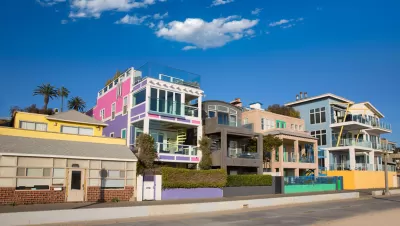By exiling short-term renters, the coastal city of Santa Monica shifts its housing burden onto neighboring areas. That burden, according to this op-ed, contradicts the city's sustainability commitment and further limits scarce residential options.

Santa Monica occupies prime real estate in coastal West Los Angeles (though it is an independent city), and attracts a sizable tourist crowd. Recently, the city chose to ban short-term rentals of less than 30 days when the owner is absent. "Residents complain that tourists make poor neighbors, hotels resent the competition for guests, and affordable housing advocates say Airbnb drives rents up by removing housing from the long-term rental market."
Paavo Monkkonen and Nate Holmes criticize the decision, writing that the ban "will simply push perceived negatives to other cities and neighborhoods in the region. After all, Santa Monica has not eliminated its own attractiveness as a destination for tourists."
Furthermore, the ban contradicts Santa Monica's environmental commitment: "consider how many people will be adding to congestion on the 10 and the 405 to get to Santa Monica instead of walking or bicycling from a local Airbnb."
Santa Monica's reluctance to allow Airbnb, Monkkonen and Holmes argue, reflects the popular city's wider unwillingness to welcome new residential development.
FULL STORY: Santa Monica’s problematic ban on short-term rentals

Alabama: Trump Terminates Settlements for Black Communities Harmed By Raw Sewage
Trump deemed the landmark civil rights agreement “illegal DEI and environmental justice policy.”

Study: Maui’s Plan to Convert Vacation Rentals to Long-Term Housing Could Cause Nearly $1 Billion Economic Loss
The plan would reduce visitor accommodation by 25% resulting in 1,900 jobs lost.

Planetizen Federal Action Tracker
A weekly monitor of how Trump’s orders and actions are impacting planners and planning in America.

Wind Energy on the Rise Despite Federal Policy Reversal
The Trump administration is revoking federal support for renewable energy, but demand for new projects continues unabated.

Passengers Flock to Caltrain After Electrification
The new electric trains are running faster and more reliably, leading to strong ridership growth on the Bay Area rail system.

Texas Churches Rally Behind ‘Yes in God’s Back Yard’ Legislation
Religious leaders want the state to reduce zoning regulations to streamline leasing church-owned land to housing developers.
Urban Design for Planners 1: Software Tools
This six-course series explores essential urban design concepts using open source software and equips planners with the tools they need to participate fully in the urban design process.
Planning for Universal Design
Learn the tools for implementing Universal Design in planning regulations.
Caltrans
Smith Gee Studio
Institute for Housing and Urban Development Studies (IHS)
City of Grandview
Harvard GSD Executive Education
Toledo-Lucas County Plan Commissions
Salt Lake City
NYU Wagner Graduate School of Public Service





























